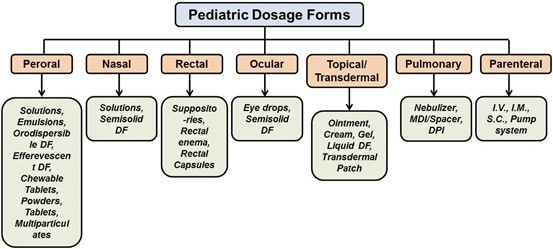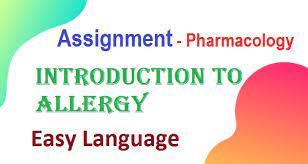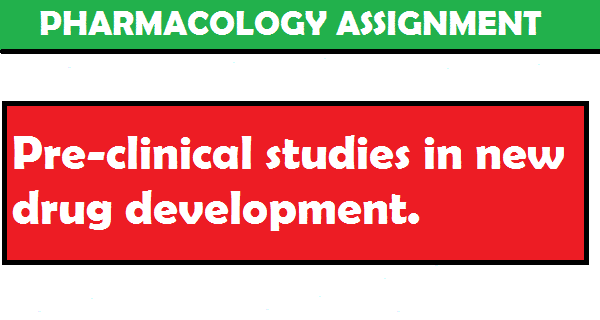Abstract
The development of age-adapted dosage forms and taste-masking of bitter-tasting drugs administered orally for children, are formidable challenges for formulation scientists. Childhood is a period of maturation requiring knowledge of developmental pharmacology to establish dose but the ability of the child to manage different dosage forms and devices also changes.
Paediatric formulations must allow accurate administration of the dose to children of widely varying age and weight. Whilst the oral route will be preferred for long term use and the intravenous route for the acutely ill, many of the dosage forms designed for adults, such as oro-dispersible tablets, buccal gels and transdermal patches, would also benefit children if they contained an appropriate paediatric dose.
Introduction
Pediatric formulations refer to drug products specifically designed and formulated for use in children. These formulations take into account various factors such as the child’s age, weight, developmental stage, and physiological characteristics to ensure safety, efficacy, and ease of administration. Pediatric formulations can come in various dosage forms including oral liquids, chewable tablets, orally disintegrating tablets, powders for reconstitution, and suspensions.
The availability of pediatric formulations depends on several factors including regulatory requirements, market demand, and the specific needs of pediatric patients.
Requirement for dosage forms
There are various reasons for the formulation of drugs into appropriate dosage forms; one of the most important relates to accurate measurement of the dose. Many active drugs are very potent and only require milligram or microgram amounts to be administered. For children the amount of drug required for the dose varies with age and weight. Active drugs must be diluted in a vehicle which allows accurate and convenient dose measurement.

Active drugs must also be protected during their shelf life from degradation, for example by oxygen and humidity and, when administered orally, may require protection from degradation by gastric acid. It may be necessary to conceal taste and smell and to produce liquid preparations of insoluble or unstable drugs. There may be a requirement for rate controlled action or optimization of delivery of topical or inhalational drugs and those delivered by injection must be sterilized.
Some drugs commonly available in pediatric formulations include:
- Antibiotics: Drugs such as amoxicillin, azithromycin, and cefixime are often formulated as pediatric suspensions or chewable tablets to make them easier to administer to children who may have difficulty swallowing pills.
- Analgesics and Antipyretics: Acetaminophen (paracetamol) and ibuprofen are commonly available in pediatric formulations such as oral suspensions or chewable tablets for the management of pain and fever in children.
- Antihistamines: Cetirizine, loratadine, and diphenhydramine are examples of antihistamines that may be available in liquid or chewable tablet forms for the treatment of allergies or allergic reactions in children.
- Respiratory Medications: Inhalers containing bronchodilators (e.g., albuterol) or corticosteroids (e.g., fluticasone) are often used in children with asthma or other respiratory conditions. These medications may also be available in nebulizer solutions or oral formulations for pediatric use.
- Gastrointestinal Medications: Proton pump inhibitors (e.g., omeprazole), antacids, and medications for the treatment of gastrointestinal reflux or nausea may be available in liquid or orally disintegrating tablet formulations for pediatric patients.
- Vaccines: Various vaccines are specifically formulated and dosed for pediatric use according to age and immunization schedules recommended by health authorities.
- Nutritional Supplements: Pediatric formulations of vitamins, minerals, and other nutritional supplements are available to support healthy growth and development in children.
- Antiretroviral Drugs: Pediatric formulations of antiretroviral medications are essential for the treatment of HIV/AIDS in children, and efforts are made to ensure their availability and accessibility in regions with high HIV prevalence among pediatric populations.
It’s important to note that the availability of pediatric formulations may vary by region, and healthcare providers should consult local formularies and prescribing guidelines when selecting appropriate medications for pediatric patients. Additionally, pharmacists and healthcare professionals can provide valuable information and guidance regarding the selection, preparation, and administration of pediatric formulations based on the individual needs of each child.
You May Like: Pre-clinical studies in new drug development
You May Like: Drug Facts Labels of US FDA in Easy Language
You May Like: Introduction to Toxicity Studies
Ages and abilities
Childhood is characterized by periods of rapid growth, maturation and development. The ability to handle active drugs changes during childhood and is recognized in developmental pharmacology. There is a change in the magnitude of dose required during childhood and adolescence which may be fifty-fold.
Paediatric practice requires a range of dosage forms that are acceptable at different ages and abilities and a range of strengths or concentrations allowing administration of the correct age-related dose. Seriously ill children will require intravenous drug administration and will prefer this to frequent intramuscular injections. For less serious illness and long-term administration the oral route will be preferred but other routes such as buccal, nasal, transdermal and rectal can be useful in some circumstances.
Challenges and knowledge gaps
There are many gaps in our knowledge about paediatric formulations and many challenges for industry to face if suitable preparations are to be available for all age ranges. These include:
- acceptable dose volumes and sizes
- safety, e.g. risk of aspiration or choking for solid dosage forms
- excipient acceptability
- taste
Reference
- Tan E, Cranswick NE, Rayner CR, Chapman CB. Dosing information for paediatric patients: are they really ‘therapeutic orphans’? Med J Aust. 2003;179(4):195–8. [PubMed] [Google Scholar]
- European Medicines Agency. Guideline on pharmaceutical development of medicines for paediatric use. EMA/CHMP/QWP/805880/2012 Rev. 2.
- World Health Organization. Development of Paediatric Medicines: Points to Consider in Formulation. Geneva, Switzerland: World Health Organization; 2012. WHO Technical Report Series, No. 970, Annex 5

